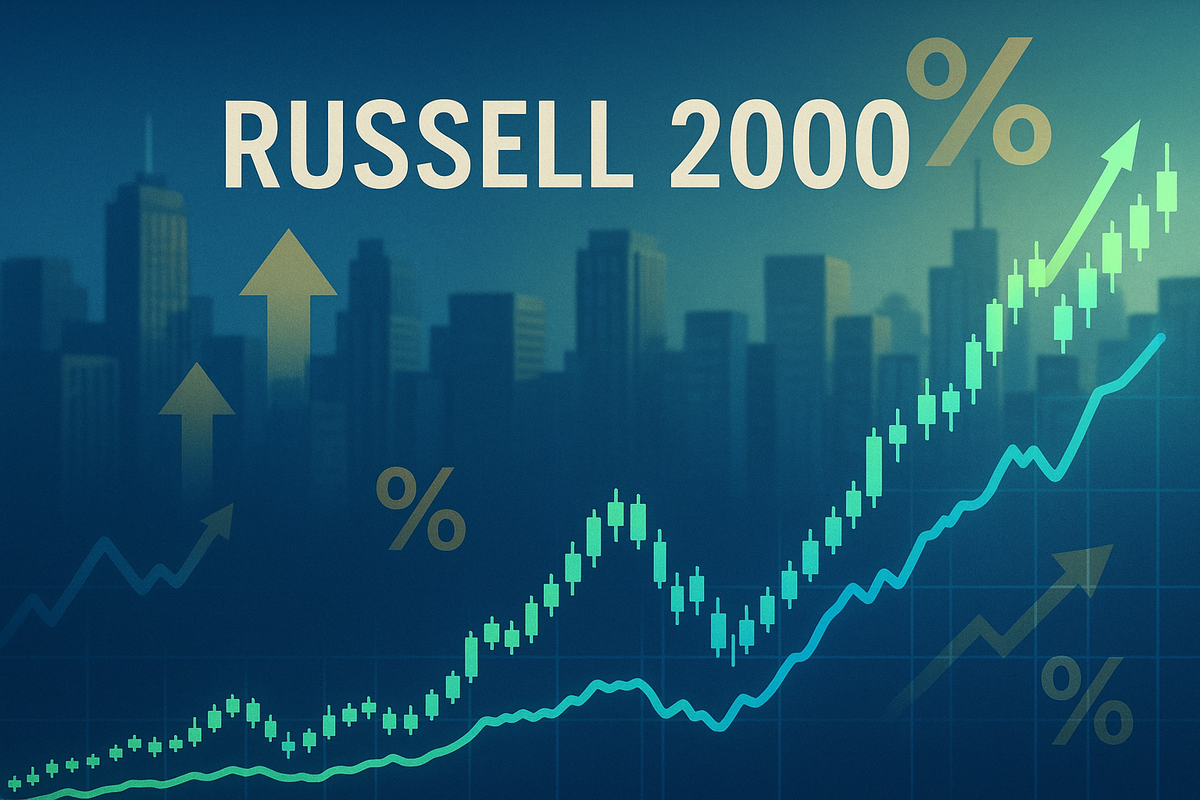
The U.S. small-cap market, as represented by the Russell 2000 index, has recently shown bursts of significant outperformance, signaling a potential shift in market dynamics and investor sentiment. This trend, particularly noticeable in August 2025 and July 2024, is largely attributed to evolving expectations surrounding the Federal Reserve's interest rate policy. While the year-to-date performance of small caps in 2025 has generally lagged behind their large-cap counterparts, these recent rallies highlight the acute sensitivity of smaller companies to interest rate fluctuations and could herald a broadening of market leadership beyond the dominant mega-cap technology stocks.
This renewed interest in small-cap stocks carries immediate implications for investors, suggesting a potential need for portfolio rebalancing and a closer look at valuation opportunities within this segment. The market is keenly watching whether these short-term gains can translate into sustained outperformance, which would signify a more robust economic recovery and a healthier, more diversified market environment.
Small Caps Take the Lead: What Happened and Why It Matters
The Russell 2000 (NYSEARCA: IWM), a crucial benchmark for U.S. small-cap stocks, has recently demonstrated periods of notable strength. In August 2025, the index surged by 2.9%, outperforming the S&P 500's (NYSEARCA: SPY) 1.1% gain for the same period. This follows an even more impressive showing in July 2024, when the small-cap index recorded an 8.9% increase, significantly outpacing the Dow (NYSEARCA: DIA), S&P 500, and Nasdaq (NASDAQ: QQQ). This July 2024 performance marked its best relative monthly showing against the S&P 500 since February 2000, a period often associated with the dot-com bubble.
Despite these strong short-term rallies, the broader picture for 2025 reveals a more mixed performance. The Russell 2000 has generally trailed large-cap indices year-to-date, with some reports indicating a modest 2.1% rise compared to the S&P 500's 9% gain, while others show a slight negative return. This suggests that while there have been strong bursts of small-cap activity, sustained outperformance over longer periods in the current year has been challenging. The primary driver behind these recent surges is the heightened investor optimism regarding potential interest rate cuts by the Federal Reserve. Small-cap companies are inherently more sensitive to interest rate changes because they often rely more heavily on external financing and floating-rate debt to fund their growth and operations. Lower interest rates translate directly into reduced borrowing costs, which can significantly boost their profitability and growth prospects.
For instance, a weaker-than-expected July jobs report and subsequent inflation data in July 2024 intensified expectations for Fed rate cuts, providing a "noteworthy lift" for small-cap stocks. Historically, small caps have tended to outperform large caps after the first interest rate cut following a period of rising rates. This phenomenon underscores the critical link between monetary policy and the performance of smaller, more economically sensitive businesses. The outperformance of small-cap stocks, especially after a prolonged period dominated by a few mega-cap technology companies (often dubbed the "Magnificent Seven"), is a significant development. It can signal a broadening of market leadership and a potential shift in the market cycle from a "Downturn" phase, which typically favors megacaps, to a "Recovery" phase, where capital flows to smaller, more economically sensitive stocks.
Winners and Losers in a Shifting Landscape
The recent outperformance of small-cap stocks creates a distinct set of winners and losers across the market, with implications for various companies and sectors. The primary beneficiaries are, naturally, the smaller companies that comprise the Russell 2000. These are often businesses with less established cash flows and greater reliance on debt for expansion. As interest rate expectations shift towards cuts, their cost of capital decreases, directly improving their financial health and growth potential.
Companies in sectors such as regional banking, industrials, and consumer discretionary, which are heavily represented in the small-cap universe and are more sensitive to economic cycles, stand to gain significantly. For example, regional banks, which often have a higher proportion of floating-rate loans and deposits, can see their net interest margins improve as borrowing costs decline. Similarly, small industrial firms and consumer discretionary companies, whose fortunes are closely tied to consumer spending and economic activity, benefit from a more favorable lending environment that encourages investment and consumption.
Conversely, large-cap companies, particularly those in the technology sector that have dominated market performance in recent years, might see a relative slowdown in their outperformance. While these companies are generally less sensitive to interest rate changes due to their robust cash flows and lower reliance on external financing, a broader market rotation towards small caps could divert investor attention and capital. This doesn't necessarily mean these large-cap giants will underperform in absolute terms, but their relative dominance might wane as other segments of the market gain traction.
Furthermore, companies with high levels of fixed-rate debt might not experience the same immediate benefits from declining interest rates as those with floating-rate obligations. While a general easing of monetary policy is broadly positive, the direct impact on their balance sheets might be less pronounced in the short term. Investors who have been heavily concentrated in a few mega-cap growth stocks might also find themselves on the "losing" side of this shift if they do not diversify their portfolios to capture the potential upside in small caps.
Industry Impact and Broader Implications
The recent outperformance of small-cap stocks and their heightened sensitivity to interest rate changes have significant implications for various industries and the broader economic landscape. This event fits into a broader trend of market participants anticipating a pivot in monetary policy, moving away from the aggressive rate hikes seen in previous periods. A sustained rally in small caps often signals a more robust and broad-based economic recovery, as these companies are typically more domestically focused and reflective of the underlying health of the U.S. economy.
The potential ripple effects on competitors and partners are substantial. For instance, smaller companies often serve as suppliers or customers to larger corporations. A healthier small-cap sector can lead to increased demand for goods and services from larger suppliers, or provide more stable and innovative partnerships for larger firms. Conversely, if small businesses struggle due to high borrowing costs, it can create headwinds for their larger counterparts. This interconnectedness means that the performance of the Russell 2000 is not just an isolated event but a barometer for the broader economic ecosystem.
From a regulatory and policy perspective, a sustained period of small-cap outperformance could influence future monetary policy decisions. If the Federal Reserve observes a strengthening small business sector, it might reinforce their confidence in the economy's resilience, potentially allowing for a more measured approach to future rate adjustments. Historically, periods of small-cap strength have often coincided with economic expansions, and policymakers closely monitor these trends as indicators of economic health. Comparing this to historical precedents, small-cap rallies often occur at the onset of economic expansions and during recessions, as investors seek undervalued assets with higher growth potential. The current environment, characterized by subdued growth, contained inflation, and limited recession risk, coupled with preemptive Fed easing, could create a constructive environment for small-cap returns, reminiscent of past recovery phases.
However, it's crucial to acknowledge that small caps are generally more susceptible to price swings due to fewer resources and more limited products. This inherent volatility means that while the upside potential is significant, so too are the risks. The current valuation spread between the Russell 2000 and the large-cap focused Russell 1000 Index (NYSEARCA: IWB) has been noted as the widest since the early 2000s tech bubble, suggesting potential undervaluation. However, some caution that the Russell 2000's price-to-earnings (P/E) ratio of 16.3x is already above average, indicating elevated valuations in some segments.
What Comes Next
The recent outperformance of small-cap stocks, driven by shifting interest rate expectations, sets the stage for several potential scenarios in the coming months. In the short term, continued optimism around interest rate cuts could fuel further rallies in the Russell 2000. Investors will be closely watching upcoming inflation data and Federal Reserve announcements for any signals that could confirm or contradict the current market sentiment. If the Fed indeed proceeds with rate cuts, it would likely provide a significant tailwind for small caps, potentially leading to a more sustained period of outperformance.
In the long term, the sustainability of this trend will largely depend on the actual trajectory of interest rates and the broader economic environment. A healthy and growing economy where earnings can deliver is crucial for small caps to maintain their momentum. If economic growth falters or inflation proves more persistent than anticipated, leading to a more hawkish stance from the Fed, small-cap stocks could face renewed headwinds. This highlights the need for investors to remain agile and adapt their strategies based on evolving macroeconomic conditions.
Potential strategic pivots or adaptations required for investors include a re-evaluation of portfolio allocations. After years of large-cap dominance, the current environment might necessitate increasing exposure to economically sensitive mid- and small-cap sectors, diversifying beyond the concentrated growth and technology stocks that have led the market. This could involve investing in small-cap focused exchange-traded funds (ETFs) or actively managed small-cap funds. Market opportunities may emerge in specific small-cap sectors that are particularly sensitive to interest rate changes or poised for growth in a recovering economy. Conversely, challenges could arise from increased volatility and lower liquidity inherent in the small-cap universe.
Potential scenarios and outcomes range from a full-blown small-cap led bull market, where these companies drive overall market gains, to a more modest rotation where small caps simply catch up to their large-cap peers. Another scenario could see a more volatile and choppy performance, with intermittent rallies and pullbacks, as the market grapples with economic uncertainties. Investors should also consider the importance of active management in this segment, as identifying quality businesses and mitigating risks within the diverse small-cap universe requires careful analysis.
Conclusion
The recent outperformance of small-cap stocks, particularly the Russell 2000, marks a significant development in the financial markets, largely driven by evolving expectations surrounding interest rate policy. This trend underscores the acute sensitivity of smaller companies to borrowing costs and signals a potential broadening of market leadership beyond the dominant mega-cap technology firms. While short-term gains have been notable, the long-term sustainability of this outperformance hinges on the actual trajectory of interest rates and the broader economic environment.
Moving forward, investors should closely monitor inflation data, Federal Reserve communications, and economic growth indicators. The potential for portfolio rebalancing to include greater exposure to economically sensitive small-cap sectors is a key takeaway. While attractive valuations exist in some segments of the small-cap market, investors must also be mindful of the inherent volatility and lower liquidity associated with these stocks. Active management will likely play a crucial role in navigating this segment, allowing for the identification of quality businesses and the mitigation of risks.
The lasting impact of this event could be a more diversified and resilient market, less reliant on a handful of large companies for overall performance. A sustained small-cap rally would not only benefit investors but also signal a healthier, more broad-based economic recovery. What investors should watch for in the coming months are clear signals from the Federal Reserve regarding interest rate cuts, consistent economic growth, and the continued ability of small-cap companies to deliver strong earnings in a potentially more favorable operating environment. The current moment presents both opportunities and challenges, demanding a nuanced and informed approach from market participants.








